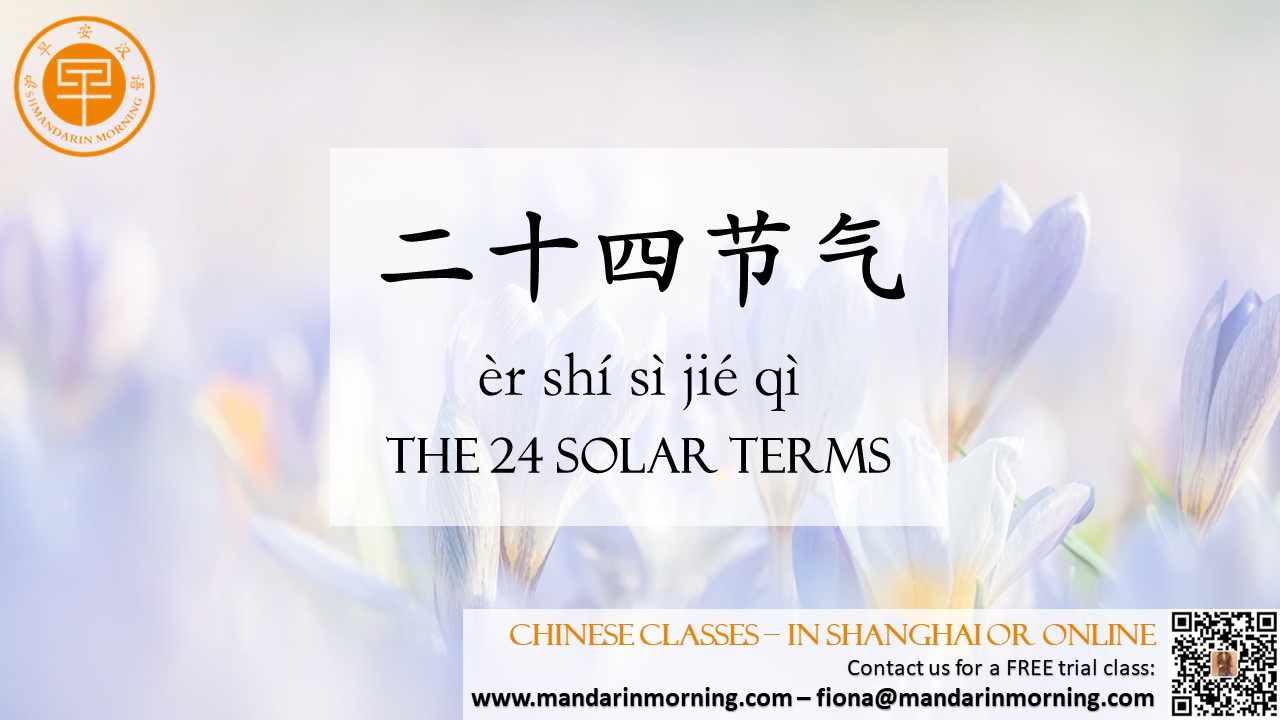【Learn Chinese】The 24 Solar Terms in Chinese (Part 1) |
| The 24 Solar Terms, or 二十四节气 (èr shí sì jiéqì), is a traditional Chinese calendar system that divides the year into 24 periods, each lasting about two weeks. The system captures the essence of each season, marking the changes in the natural world. These terms, based on the sun’s position in the zodiac, were created by farmers in ancient China and have guided agricultural practices, culinary traditions, and daily life for generations.  01. Lichun or Beginning of Spring Lichun (立春 Lìchūn) marks the beginning of spring. Although spring is still cold at this time, the daylight hours gradually begin to lengthen. On the first day of Lichun, there’s a tradition known as “biting spring” (咬春 yǎo chūn). People celebrate by eating 春饼 (chūnbǐng) – spring pancakes filled with vegetables and meat. They also enjoy other seasonal foods like five-spice dishes and radishes. 02. Yushui or Rain Water You probably noticed the rainy weather in February, didn’t you? As the Rain Water (雨水 Yǔshuǐ) arrives, temperatures begin to rise, and rainfall becomes more frequent. 03. Jingzhe or Insects Wake 惊蛰 (Jīngzhé), the Insects Wake is the time when hibernating insects begin to awaken as spring approaches. In terms of TCM, the Insects Wake is seen as a time to focus on taking care of health by eating pears. During this season, the temperature changes frequently, and the climate is relatively dry, which can lead to dry mouth and coughing. Eating pears can help support the body during this period. 04. Chunfen or Spring Equinox The Spring Equinox, or 春分 (Chūnfēn) marks the midpoint of the spring season. During the Spring Equinox, the day and night are approximately equal in length. With the weather warming up, it’s the perfect time for outdoor activities. In China, one popular tradition during this season is flying kites. 05. Qingming or Pure Brightness During this term it is clear and bright, and the weather becomes noticeably warmer. The season marks a traditional Chinese festival called 清明节 (Qīngmíng Jié), or Tomb Sweeping Day. It is a time to pay respects to ancestors by visiting their graves, cleaning the tombstones, and making offerings of food and other items. 06. Guyu or Grain Rain 谷雨 (Gǔyǔ), or Grain Rain, marks the end of the spring rainy season, and it is an important time for agriculture, which signifies the time when crops such as barley and wheat start to ripen. Farmers begin to prepare their fields for the upcoming harvest, and the weather becomes more stable, with less rain and more sunshine. 07. Lixia or Start of Summer As the spring is ready to end, people welcome the first solar term in summer, 立夏 (Lìxià). The term consists of two Chinese characters: 立 (lì), meaning “establish” or “begin,” and 夏 (xià), meaning “summer”. Certain foods are traditionally eaten during specific solar terms, and one of the traditions during Lixia also relates to food. People would cook “seven-family porridge”, or 七家粥 (qī jiā zhōu). Traditionally, they would ask for rice from their neighbors, cook it with multicolored beans and brown sugar, and share with family, friends, and neighbors. 08. Xiaoman or Lesser Full Grain The term 小满 (Xiǎomǎn) reflects the idea that grains are beginning to fill but are not yet fully ripe. The increased rainfall fills rivers, making The Lesser Full Grain a perfect time for enjoying fresh fish. 09. Mangzhong or Grain in Ear Mangzhong 芒种 (mángzhòng), or Grain in Ear, is the 9th of the 24 Solar Terms in the traditional Chinese calendar. It usually falls around June 5th each year and marks the time when crops start to grow grains. In TCM, Mangzhong is time to focus on nourishing the heart and calming the mind. People may consume foods that are light and easy to digest, such as vegetables and fruits, to support their bodies during this period. 10. Xiazhi or Summer Solstice Xiazhi 夏至 (xiàzhì) marks the longest day and shortest night of the year in the Northern Hemisphere, when the sun reaches its highest point in the sky. After Xiazhi, the days begin to shorten, and the nights gradually become longer. In much of China, it is traditional to eat noodles on the Summer Solstice. As the popular saying goes: 冬至饺子夏至面 (dōngzhì jiǎozi Xiàzhì miàn) - Winter Solstice eat dumplings, Summer Solstice eat noodles. 11. Xiaoshu or Lesser Heat 小暑 (Xiǎoshǔ), the Lesser Heat marks the period of time when the weather becomes noticeably hotter. It is important take precautions against the heat of summer and to take care of health: stay hydrated, seek shade, and avoid prolonged exposure to the sun. 12. Dashu or Great Heat During Dashu 大暑 (dàshǔ), temperatures are at their peak. It is the time of year when the duration of the sunshine is the longest, the rainfall is the greatest, and the thunderstorms are the most frequent. |